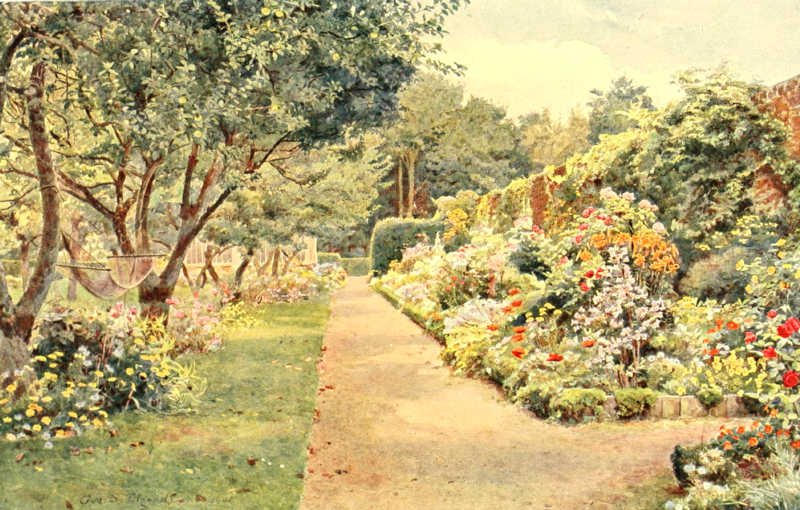| Web
and Book design,
Copyright, Kellscraft Studio 1999-2021 (Return to Web Text-ures) |
 (HOME)
|
|
MYNTHURST
At
the time the picture was painted, Mynthurst was in the occupation of Mrs.
Wilson, to the work of whose niece. Miss Radcliffe, the garden owes much of its
charm. It lies
in the pleasant district between Reigate and Dorking, on a southward sloping
hill-side. The house is a modern one of Tudor character, standing on a terrace
that has a retaining wall and steps to a lower level. The garden lies open to
the south and south-westerly gales, the prevalent winds of the district, but it
is partly sheltered by the walls of the kitchen garden, and by a yew hedge
which runs parallel with one of the walls; the space so inclosed making a
sheltered place for the rose garden. Here Roses rise in ranks one above the
other, and have a delightful and most suitable carpet of Love-in-a-mist. This
pretty annual, so welcome in almost any region of the garden, is especially pretty
with Roses of tender colouring; whites, pale yellows, and pale pinks. A picture
elsewhere shows it combined with Rose Viscountess Folkestone. Beyond
the rose garden, a path leads away at a right angle between the orchard and the
kitchen-garden wall. Here is the subject of the picture. A broad border runs
against the wall, as long as the length of the kitchen garden. A border so wide
is difficult to manage unless it has a small blind alley at the back rather
near the wall, to give access to what is on the wall and to the taller plants
in the back of the border. But here it is arranged in another way. The front
edge of the border is not continuous, but has little paths at intervals cutting
across it and reaching nearly to the wall. This method of obtaining easy access
also has its merits, though it involves
a large amount of edging. Mynthurst has a strong soil, an advantage not always
to be had in this district, so that Roses can be well grown, and some of the
Lilies. Here the Tiger Lily, that fine autumn flower, does finely. It is one of
the Lilies that is puzzling, or as we call it, capricious, which only means
that we gardeners are ignorant and do not understand its vagaries. For in some other
heavy soils it refuses to grow, and in some light ones it luxuriates; but it is
so good a plant that it should be tried in every garden. It is
a pretty plan to have the orchard in connexion with the flower-borders; though
from the point of view of good gardening the wisdom is doubtful of having
clumps of flowers round the trunks of the fruit-trees. Shallow-rooted annuals
for a season or two may do no harm, but the disturbance of the ground needful
for constant cultivation, with the inevitable consequence of worry and
irritation of the fruit-trees' roots, can hardly fail to be harmful, though the
effect meanwhile is certainly pretty. The evil may not show at once, but is
likely to follow. One
does not often see so strong a Canterbury Bell in the autumn as the one in the
picture. It must have been a weak or belated plant of last year that made
strong growth in early summer. Sometimes one sees such a plant that had
remained in the kitchen-garden reserve bed; left there because it was weaker
than the ones taken for planting out in autumn. It is not generally known that
these capital plants will bear potting when they are almost in bloom, so that
when a few are so left, they can be used as highly decorative room plants, and
have the advantage of lasting much longer than when in the open border, exposed
to the sun. One defect these good plants have, which is the way the dying flowers
suddenly turn brown. Instead of merely fading and falling, and so decently
veiling their decadence, the brown flowers hang on and are very unsightly. It
is only, however, a challenge to the vigilance of the careful gardener; they
must be visited in the morning garden-round and the dead flowers removed. It is
like the care needed to arrest the depredations of the mullein caterpillar. It
is no use wondering whether it will come, or hoping it will not appear; it
always comes where
there are mulleins, about the second week of June. When the first tiny enemy is
seen, any mulleins there may be should be visited twice a day.  MYNTHURST From the picture in the possession of Miss Radcliffe In the front of the picture, just under the red rose, is a patch of Mimulus, one of the larger variations of the brilliant little M. cardinalis. All the kinds like a cool, strong soil; they are really bog plants, and revel in moisture. The old Sweet Musk, so favourite a plant in cottage windows, likes a half-shady place at the foot of a cool wall. Many a dull, sunless yard might be brightened by this sweet and pretty plant. The Welsh Poppy, with its bright pale-green leaves and good yellow bloom, is also excellent for the same use, but is best sown in place from a just-ripened pod. |